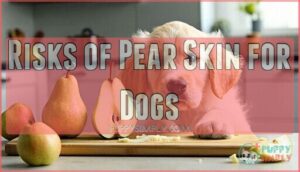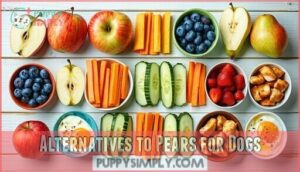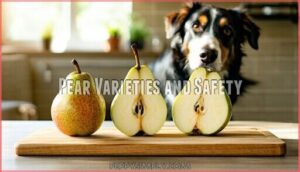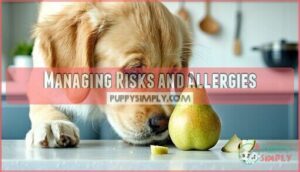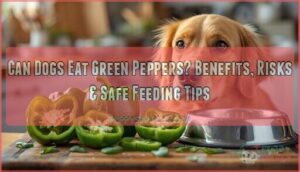This site is supported by our readers. We may earn a commission, at no cost to you, if you purchase through links.

Always wash the pear thoroughly to remove any pesticides or dirt, as your pup doesn’t need a side of chemicals with their treat.
Make sure to slice the pear into small, bite-sized pieces so it’s easier—and safer—for them to chew.
The skin itself is safe and even contains fiber, but it could upset sensitive stomachs in some dogs, so moderation is key.
Avoid the seeds and core altogether, as they can be harmful.
Pears make a sweet, healthy snack when prepared carefully!
Table Of Contents
- Key Takeaways
- Can Dogs Eat Pears
- Dogs Eating Pear Skin
- Health Benefits of Pears
- Risks of Pear Skin for Dogs
- Preparing Pears for Dogs
- Safe Pear Serving Tips
- Pear Varieties and Safety
- Feeding Pears to Puppies
- Managing Risks and Allergies
- Consulting a Veterinarian
- Frequently Asked Questions (FAQs)
- How much of a pear can a dog eat?
- Is it okay for dogs to eat apples and pears?
- What if my dog eats pear seeds?
- Is it safe to feed pear skin to puppies?
- Does pear skin contain any toxins?
- Are there any other benefits to feeding pear skin to dogs?
- Are there any other risks associated with feeding pear skin to dogs?
- How much pear skin should I feed my dog?
- Can pears be included in homemade dog treats?
- Is it safe to cook pears for dogs?
- Conclusion
Key Takeaways
- Wash pears thoroughly to remove pesticides and dirt before giving them to your dog.
- Pear skin is safe and rich in fiber but could upset sensitive stomachs, so feed it in moderation.
- Always remove seeds and the core, as they contain cyanide and pose choking hazards.
- Cut pear skin into small, bite-sized pieces to prevent choking and aid digestion.
Can Dogs Eat Pears
You can safely feed your dog pears as an occasional treat, provided you remove the seeds, core, and cut them into appropriate sizes to prevent choking hazards.
Pears offer valuable nutrients like vitamins C and K, fiber, and antioxidants that support your dog’s immune system, digestion, and overall health when served in moderation.
Nutritional Benefits of Pears
Pears offer a nutritional goldmine for your furry companion when served appropriately.
A juicy pear is a natural treasure trove of fiber, vitamins, and hydration, perfect as an occasional treat for your dog!
These juicy fruits pack impressive health benefits that can complement your dog’s regular diet.
- Pear skin contains the highest concentration of fiber benefits, supporting healthy digestion and regular bowel movements
- Rich vitamin content includes immune-boosting C and bone-strengthening K
- Essential mineral sources like potassium, copper, and magnesium support heart function
- Powerful antioxidants fight inflammation while providing natural hydration effects
Risks of Feeding Pears to Dogs
While pears offer nutritional benefits, they’re not without risks for your furry friend.
Seeds contain traces of cyanide, which can be toxic if consumed in large quantities.
Pear skin, though nutritious, may present a choking hazard, especially for smaller dogs.
Watch for digestive upset or allergic reactions when introducing pears, as the natural sugar content could contribute to weight gain or dental issues.
Always practice choking prevention by cutting pears into appropriate sizes for your dog’s safety.
Dogs Eating Pear Skin
While many dog owners wonder about fruits in their pet’s diet, you can safely feed your furry friend pear skin in moderation.
The skin actually contains the highest nutrient density of the fruit, offering additional fiber and beneficial compounds not found in the flesh alone.
However, pear skin benefits come with potential pesticide contamination risk, making thorough washing absolutely essential before serving.
Some breeds may show skin sensitivity to certain fruits, so watch for any unusual reactions after introducing pear skin for dogs.
Though rare, glycoalkaloid concerns exist with fruit skins, which could cause digestive upset in sensitive canines.
When prepared properly, pear skin nutrition can complement your dog’s regular diet.
Remember that moderation is key—too much fiber might lead to stomach discomfort.
Like putting on a new collar, introducing any new food requires careful observation of how your dog responds.
Remember that pears offer dietary fiber aiding your dog’s digestion.
Health Benefits of Pears
You’ll find that pears offer your dog an impressive range of nutrients, including vitamins C and K, fiber, and beneficial antioxidants that support immune function and digestive health.
These juicy fruits can help maintain your dog’s overall wellbeing when served properly, with their high water content providing hydration while their natural sweetness makes them a healthier alternative to commercial treats.
Their natural sweetness and high water content make pears a great option for dogs, providing hydration and a sweet taste without the need for added sugars.
Fiber and Digestive Health
Now that you know dogs can safely enjoy pear skin, let’s explore how the fiber in pears supports your furry friend’s digestive system.
The high fiber content in pears offers excellent benefits for your dog’s gut health:
- Promotes regular bowel movements and improves stool consistency
- Supports healthy gut motility, preventing constipation
- Acts as a prebiotic, feeding beneficial gut bacteria
This soluble and insoluble fiber combination helps maintain digestive balance, though too much can cause digestive upset in sensitive pups.
Vitamins and Minerals in Pears
Beyond providing hydration to your four-legged friend, pears pack an impressive array of essential vitamins and minerals that support canine health.
You’ll find these nutritional powerhouses contribute to everything from immune function to bone development.
| Nutrient | Benefit | Location | Dog Impact |
|---|---|---|---|
| Vitamin C | Immune support | Concentrated in skin | Reduces inflammation |
| Potassium | Heart health | Throughout fruit | Supports muscle function |
| Copper | Blood cell formation | Higher in skin | Aids iron absorption |
| Magnesium | Nerve function | Skin and flesh | Promotes calm behavior |
Antioxidants and Anti-Inflammatory Properties
Several powerful antioxidants in pear skin work tirelessly to provide cellular protection for your dog.
The vitamin C and phytonutrients combat free radicals, effectively reducing inflammation that can lead to chronic disease. These compounds strengthen your pup’s immune system while supporting joint health.
The highest concentration of these beneficial compounds is found in the skin itself, making pear skin nutritional value substantially higher than the flesh alone, due to the presence of phytonutrients and antioxidants.
Risks of Pear Skin for Dogs
While pear skin isn’t toxic to dogs, it can present several potential risks including choking hazards and digestive upset, especially in smaller breeds or those with sensitive stomachs.
You’ll need to be vigilant about thoroughly washing pears to remove pesticides and always remove seeds, stems, and cores, which contain trace amounts of cyanide that could harm your furry friend.
Choking Hazards and Obstructions
While pears offer excellent nutrition, the physical structure of pears presents serious choking hazards for your furry friend.
Pear cores can become dangerous obstructions if swallowed whole, potentially causing intestinal blockage requiring emergency veterinary care.
Pears offer essential nutrients for dogs, contributing to their overall health and well-being.
When feeding pears to your dog, always remember:
- Remove stems completely – they’re unexpected choking risks
- Cut pears into appropriate piece sizes based on your dog’s size
- Never offer unripe pears as they’re harder to chew
- Always supervise chewing to prevent swallowing difficulties
Cyanide Poisoning From Seeds
Pear seeds may seem harmless, but they hold a hidden danger—cyanide. Though the amount is small, chewing releases the toxin, which can cause cyanide poisoning in dogs.
Symptoms include rapid breathing, dilated pupils, or seizures. Remove seeds completely to avoid pear cyanide risks.
Keeping portions safe guarantees your pup enjoys pears without risk to their health.
Digestive Issues and Allergic Reactions
Dog allergies to pear skin can lead to gastrointestinal issues, so keep an eye out for signs of discomfort.
Here’s how to protect your pup:
- Watch for allergic symptoms like itching or vomiting.
- Limit pear skin to avoid fiber overload.
- Gradual introduction helps spot sensitivities.
- Avoid sugar-related digestive system troubles.
- Test small pieces to prevent food allergies.
Preparing Pears for Dogs
Preparing pears for your dog is simple but requires a bit of care to keep them safe and healthy.
By washing the fruit, removing the seeds and core, and cutting it into bite-sized pieces, you can guarantee a tasty and safe treat for your furry friend.
Removing Seeds and Cores
Removing seeds and cores from pears is key to avoiding cyanide risk and seed toxicity.
Pear seeds, containing cyanogenic compounds, pose a choking hazard, especially for small dogs.
The core texture is dense and tough, making it unsafe for easy chewing.
Safe removal guarantees that pears remain a healthy and safe fruit for dogs to enjoy as occasional treats.
Cutting Pears Into Small Pieces
After removing seeds and cores, cut pears into small, bite-sized pieces.
This helps with choking prevention, especially for smaller dogs or puppies. Proper pear preparation also makes digestion easier and makes certain a safe serving size.
If your dog struggles to chew, mash alternatives might be safer. A dog food chopper can help with this.
Always consider the risk of a choking hazard when serving pears.
Washing Pears Thoroughly
Before feeding pears to your dog, rinse them thoroughly under running water to wash off pesticides, dirt, and other contaminants.
For extra care, use organic washing techniques like a baking soda scrub. Safe consumption starts with pear skin that’s clean and free of risks.
A dirty pear could hide pesticide dangers, so take a moment to guarantee its purity. Proper cleaning involves understanding effective washing products, which is crucial for safe consumption and ensuring the pear is clean.
Safe Pear Serving Tips
Serving pears to your dog is safe and simple if you follow a few key steps to protect their health.
By using proper preparation and keeping portions small, you can offer this fruit as a tasty, occasional treat.
Moderation and Occasional Treats
In the context of dog treats, less is more. Pear moderation guarantees your pup stays healthy while enjoying a tasty snack.
Focus on portion control for a balanced diet, keeping it occasional.
- Offer treats no more than 10% of daily calories.
- Limit portions to 1–6 chunks based on size.
- Opt for fresh pear.
- Skip canned versions.
- Explore healthy alternatives.
Monitoring Digestive Reactions
After offering pears, pay attention to your dog’s stool consistency, gas production, and appetite changes.
Watch for vomiting signs or allergy symptoms that hint at pear digestion issues.
Pear skin can be tricky for some dogs’ digestive health, causing upset stomachs.
Here’s a quick guide:
| Signs to Watch | Potential Cause | Recommended Action |
|---|---|---|
| Loose stools | Fiber overload | Reduce serving size |
| Vomiting | Allergic reaction | Stop pears, call vet |
| Gas buildup | Poor pear digestion | Serve smaller portions |
To address potential issues, it is essential to monitor your dog’s health closely and take recommended actions based on the signs observed, such as reducing the serving size for loose stools or stopping pears altogether in case of vomiting.
Alternatives to Pears for Dogs
If pears aren’t your dog’s favorite, fruity substitutes and other healthy alternatives are a great option.
Try these dog-safe snacks:
- Fruit Alternatives: Apples (seedless), bananas, or blueberries.
- Veggie Options: Carrot sticks or cucumber slices for crunchy fun.
- Protein Treats: Cooked chicken bites or scrambled eggs.
For a twist, check commercial alternatives or homemade recipes for unique dog treat alternatives.
Consider exploring dog fruit alternatives for more ideas.
Pear Varieties and Safety
Not all pear varieties are created equal regarding your dog’s safety.
Understanding which types are safe, how to prepare them, and potential risks helps you make the best choices for your furry friend, and understanding is key to this process.
Types of Pears Safe for Dogs
When choosing pear varieties, stick to dog-friendly fruits like Bartlett pears, Asian pears, or Korean pears.
These pear varieties are safe fruits for dogs when prepared properly. However, their firm flesh can pose a choking risk, so always cut them into small pieces.
Cooked pears also work as a soft option. Fresh, ripe options keep your pet’s health in check!
Organic and Non-Organic Pears
When comparing organic pears to non-organic ones, organic options often reduce the risks of pear skin pesticide exposure.
However, they’re usually pricier. Non-organic pears may contain pesticide residues, so washing is vital to remove contaminants.
While nutrient differences are minimal, organic certification assures fewer chemicals. Regardless of choice, wash pears thoroughly to guarantee safety for your dog.
Canned and Dried Pears Risks
Canned and dried pears aren’t ideal for dogs.
They’re packed with added sugars and preservatives, which can lead to digestive irritation, weight gain, and even tooth decay.
Dried pears, with their concentrated sugars, increase the risks, including potential kidney issues.
Always prioritize dog safety by sticking to fresh pears.
Follow a proper pear safety guide to guarantee your pup’s health.
Feeding Pears to Puppies
When introducing pears to your puppy, start with very small amounts to guarantee their sensitive stomachs can handle it.
Always monitor their reaction closely, as puppies are more prone to digestive issues.
Introducing Pears Gradually
When offering pears for dogs, especially puppies, start small and focus on gradual introduction.
Their tummies can be sensitive, so mix food with tiny pear chunks and monitor stool changes.
Puppies exploring safe fruits for dogs, like pears, need tiny portions for smooth pear digestion.
Remember, patience is key with dog-friendly fruits to avoid overwhelming their systems.
- Start small with one teaspoon for puppies.
- Gradual introduction aids digestion.
- Mix food for easy adjustment.
- Monitor stool to spot any issues.
Small Serving Sizes for Puppies
When offering pears to puppies, keep portions small—about a teaspoon.
Their sensitive stomachs require patience, so a gradual introduction is best for healthy puppy digestion. Tiny amounts reduce the risk of upsetting their delicate systems.
Dog treat pears can be a fun, hydrating option, but always monitor reactions to gauge how your puppy’s digestion handles this occasional treat, with patience and monitor reactions, and remember healthy puppy digestion.
Monitoring Puppies’ Digestive Health
After introducing pears to your puppy’s diet, watch for changes in their stool to confirm their digestive system handles it well.
Gradual introduction and portion control are key to preventing upset stomachs. Keep your pup hydrated and prioritize their overall puppy diet.
If digestive issues occur, consult a vet.
Here’s how to monitor their digestion:
- Check stool texture and frequency.
- Note any gas or bloating.
- Observe for diarrhea or vomiting.
- Track energy levels and appetite.
- Schedule regular vet checkups to ensure your puppy’s health is on track, and to address any overall health concerns promptly.
Managing Risks and Allergies
When feeding your dog pear skin, it’s important to watch for potential risks like choking and allergic reactions.
By introducing pears gradually and keeping an eye on your dog’s response, you can help guarantee a safe and enjoyable treat.
Recognizing Allergic Reactions
Keep an eye on your dog’s body language after eating pear skin.
Swelling signs, skin reactions like itching, or vomiting/diarrhea can point to pear skin dog allergies or food intolerance.
Breathing problems or extreme reactions demand immediate veterinary advice.
Reaction timing varies, so always monitor closely when introducing new foods to catch any dog reactions early.
Preventing Choking Hazards
Regarding pear choking hazards, size matters. Small dogs or those with weaker chewing ability need closely supervised feeding.
Slice pear skin into tiny pieces or consider mash alternatives for safer bites. Always watch your pup as they eat—pear skin choking can be risky.
Even seemingly harmless fruits can be dangerous, as cyanide toxicity is possible with other plants. Knowing basic first aid is smart, just in case safety becomes a concern.
Addressing Digestive Issues
Digestive issues from pear skin digestion can affect dogs if not introduced gradually. Sensitive stomachs or fiber overload may cause diarrhea or gas.
Gradually introduce pear skin to avoid digestive discomfort—overloading fiber may lead to diarrhea or gas in sensitive pups.
Watch for signs like loose stools and adjust portions carefully.
Here’s how to help:
- Start with small amounts.
- Monitor stools for changes.
- Avoid overloading high-fiber foods.
- Limit natural sugar content.
- Consult your vet if issues persist.
To ensure your dog’s digestive health, it’s crucial to introduce pear skin gradually and be mindful of high-fiber foods.
Consulting a Veterinarian
If you’re unsure about feeding your dog pear skin, consulting a veterinarian is always a smart move.
They can provide personalized advice based on your dog’s size, breed, and overall health to guarantee their safety.
Professional Advice on Feeding Pears
When feeding pears to dogs, always ask your vet for recommendations customized to your pup’s unique needs.
Safe quantities depend on factors like breed and health conditions, so go slow with dietary integration.
Pear skin benefits are notable, but risks like choking or digestion troubles matter too.
Your vet’s expert advice guarantees pears support, not harm, dog nutrition, with proper integration.
Customized Dietary Recommendations
A vet can tailor dietary advice by considering your dog’s age, breed-specific needs, health conditions, and activity level.
Pear portioning is key—smaller dogs need less.
Pear skin benefits and risks should guide serving sizes.
Nutritionist advice suggests moderate fruit treats.
Breed specific puppy food can address unique nutritional needs.
Follow pear skin safety tips—slice carefully and start small—and ask experts about your pet’s unique requirements for ideal care to ensure proper nutrition.
Ensuring Overall Canine Health and Safety
Your dog’s health deserves a Safe Treats approach, so consult your vet for a Balanced Diet designed to meet their Exercise Needs.
Discuss pear skin risks and follow a pear skin safety guide to prevent pear skin toxicity. Also, ask about pear skin pesticide risks.
Regular checkups guarantee Hydration Importance, Dental Hygiene, and overall dog health.
- Maintain balanced meals and hydration.
- Prioritize exercise and dental care.
- Discuss treats like pear skin with your vet.
Frequently Asked Questions (FAQs)
How much of a pear can a dog eat?
Did you know pears are 84% water?
Dogs can enjoy a few small chunks—1-2 bites for small breeds and 5-6 for bigger ones.
Just remove seeds, stem, and core to keep things safe!
Is it okay for dogs to eat apples and pears?
Yes, apples and pears are safe for dogs in moderation.
Remove seeds, cores, and stems, cut into bite-sized pieces, and watch for any reactions.
Their vitamins and fiber make them a healthy, occasional treat!
What if my dog eats pear seeds?
When curiosity kills the cat—or in this case, pear seeds—it’s vital to act fast.
Pear seeds contain cyanide, so call your vet immediately.
Symptoms like difficulty breathing, seizures, or lethargy need urgent attention.
Is it safe to feed pear skin to puppies?
Pear skin is safe for puppies if served properly.
Wash it thoroughly, cut it into small, manageable pieces, and serve in moderation.
Monitor for any adverse reactions since puppies have sensitive stomachs and need gradual introductions to new foods, especially when introducing something like pear skin.
Does pear skin contain any toxins?
Did you know pear skin contains glycoalkaloids, which can be toxic in large amounts?
Luckily, the levels are usually safe for dogs in moderation.
Just wash the skin well and serve small, manageable pieces.
Are there any other benefits to feeding pear skin to dogs?
Feeding pear skin to dogs boosts their diet with antioxidants like lutein and zeaxanthin, which support eye health.
The skin’s natural fiber aids digestion, keeping your pup regular and happy, while also maintaining healthy gut bacteria with antioxidants.
Are there any other risks associated with feeding pear skin to dogs?
Large pieces of pear skin can pose a choking hazard, especially for smaller dogs.
It may also irritate sensitive stomachs, causing gas or diarrhea.
Always cut it small and introduce slowly to avoid issues.
How much pear skin should I feed my dog?
Think of pear skin as a sprinkle of fairy dust—beneficial in moderation.
Limit your dog’s intake to a few small, washed slices.
Too much can upset their stomach, so start small and observe.
Can pears be included in homemade dog treats?
You can absolutely include pears in homemade dog treats as long as you remove seeds and cores, wash thoroughly, and use moderation.
Pears add natural sweetness, fiber, and vitamins, making them a delightful, healthy addition.
Is it safe to cook pears for dogs?
Cooking pears for your dog is like turning a raw idea into a masterpiece—it’s safe and enhances digestibility.
Skip the spices, cool them down, and serve in small pieces for a deliciously healthy treat.
Conclusion
Did you know pears are about 84% water, making them a hydrating treat for dogs?
While pear skin is safe and nutritious, offering fiber to support digestion, not all dogs tolerate it well.
Always wash pears, remove seeds and cores, and serve in moderation to avoid risks like choking or an upset stomach.
Remember, every dog is unique, so keep an eye on their reactions, and when prepared carefully, pears—and their skin—can be a sweet, healthy snack!




